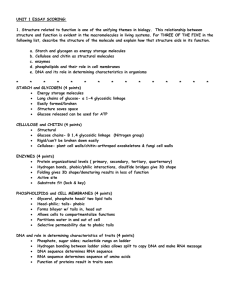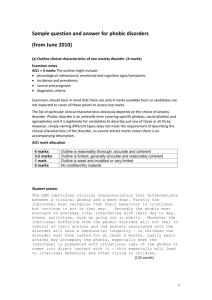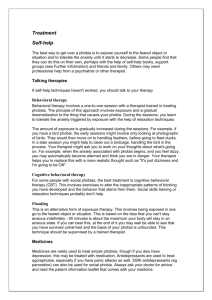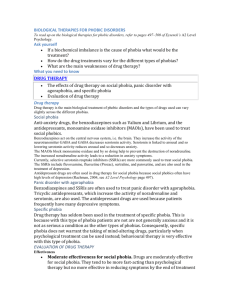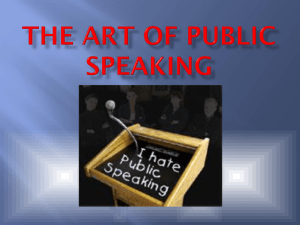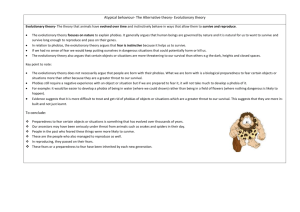Phobia Protocol
advertisement
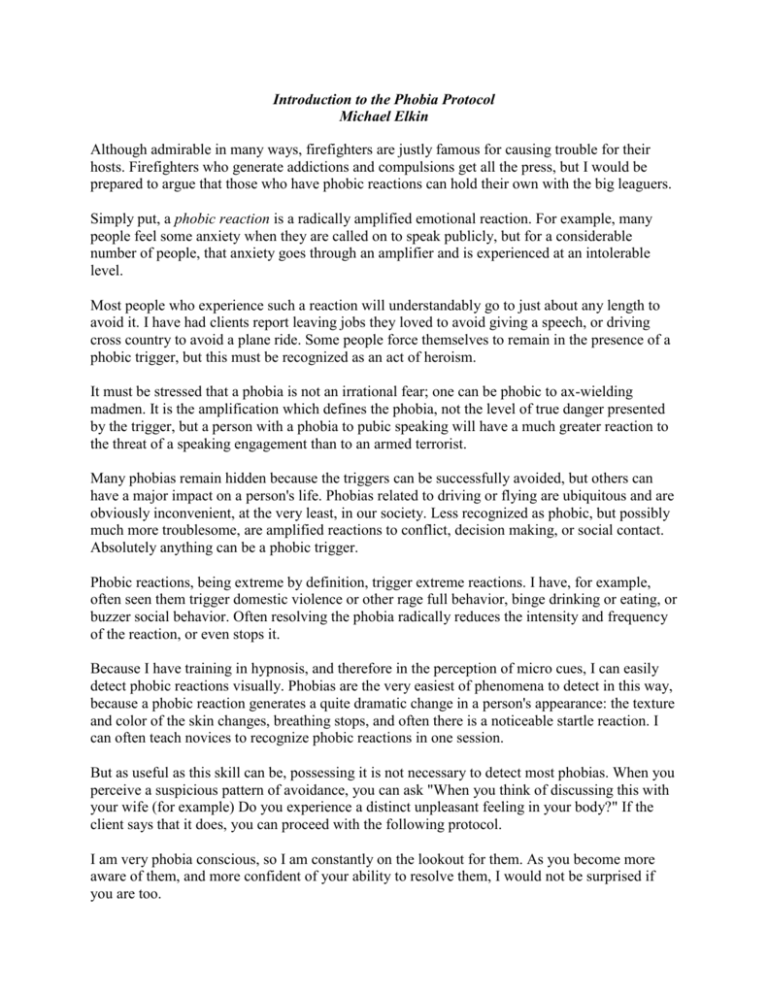
Introduction to the Phobia Protocol Michael Elkin Although admirable in many ways, firefighters are justly famous for causing trouble for their hosts. Firefighters who generate addictions and compulsions get all the press, but I would be prepared to argue that those who have phobic reactions can hold their own with the big leaguers. Simply put, a phobic reaction is a radically amplified emotional reaction. For example, many people feel some anxiety when they are called on to speak publicly, but for a considerable number of people, that anxiety goes through an amplifier and is experienced at an intolerable level. Most people who experience such a reaction will understandably go to just about any length to avoid it. I have had clients report leaving jobs they loved to avoid giving a speech, or driving cross country to avoid a plane ride. Some people force themselves to remain in the presence of a phobic trigger, but this must be recognized as an act of heroism. It must be stressed that a phobia is not an irrational fear; one can be phobic to ax-wielding madmen. It is the amplification which defines the phobia, not the level of true danger presented by the trigger, but a person with a phobia to pubic speaking will have a much greater reaction to the threat of a speaking engagement than to an armed terrorist. Many phobias remain hidden because the triggers can be successfully avoided, but others can have a major impact on a person's life. Phobias related to driving or flying are ubiquitous and are obviously inconvenient, at the very least, in our society. Less recognized as phobic, but possibly much more troublesome, are amplified reactions to conflict, decision making, or social contact. Absolutely anything can be a phobic trigger. Phobic reactions, being extreme by definition, trigger extreme reactions. I have, for example, often seen them trigger domestic violence or other rage full behavior, binge drinking or eating, or buzzer social behavior. Often resolving the phobia radically reduces the intensity and frequency of the reaction, or even stops it. Because I have training in hypnosis, and therefore in the perception of micro cues, I can easily detect phobic reactions visually. Phobias are the very easiest of phenomena to detect in this way, because a phobic reaction generates a quite dramatic change in a person's appearance: the texture and color of the skin changes, breathing stops, and often there is a noticeable startle reaction. I can often teach novices to recognize phobic reactions in one session. But as useful as this skill can be, possessing it is not necessary to detect most phobias. When you perceive a suspicious pattern of avoidance, you can ask "When you think of discussing this with your wife (for example) Do you experience a distinct unpleasant feeling in your body?" If the client says that it does, you can proceed with the following protocol. I am very phobia conscious, so I am constantly on the lookout for them. As you become more aware of them, and more confident of your ability to resolve them, I would not be surprised if you are too. THE UPDATED PH0BIA PROTOCOL 1) Contact and unblend the phobic part. Ask the client to put attention on the phobic feeling. 7here is no need to let the .feeling become strong; the merest hint will suffice. With attention on the feeling, have the client request that the part communicate, and further request that the part separate from the client's body. Ask the part to pull in its feelings, or move back until the client has no phobic bodily sensations. 2) Help the client manifest Self. Ask the client to focus attention on the phobic part, and notice reactions toward it. Have the client notice any parts feeling anything but friendly curiosity, and request that they unblend and move back. 3) Ask for a memory. Ask the client to have the part focus on that awful feeling, and let a memory from its childhood come to it. Have the client ask the part to send the memory to the client when it appears. 4) Scan the memory for a shameful feeling. Let the client know that we are looking for a feeling that the child in the memory believes is unacceptable. The child thinks that the fact he or she is having this feeling means that there is something seriously wrong with his or her character. It might be something as simple as the child is afraid, and believes that means he or she is a worthless coward. Abused children often believe that they are weak or stupid to crave the abusive parent's love or approval, even though they know they will never get it. The child may believe that reveling in admiration or praise means they are egotistical and think they are better than others, etc. 5) Have Self help the child know that there is nothing wrong with them or their feelings. You can coach Self to cognitively reorient the child. Once it is clear the child really gets this, 6) Have the part return to the phobic situation. There should be NO phobic response. Have the client imagine other aspects of the phobic experience to discover related phobias. IFS-Based Phobia Protocol Practice Sheet Michael Elkin Description: This protocol was developed to reduce the amplitude of autonomic arousal experienced by a person suffering from a phobic response. This protocol is effective in working with phobias, violence, binge eating and drinking, and other extreme firefighter behaviors. 1) Observe physiological indicators of phobia (breathing, muscle tonus, skin coloration and texturing (e.g., flushing, etc.) 2) Discuss with client the autonomic responses noticed in the present moment. Bring in a triggering stimulus or reference to that stimulus to elicit the phobic response. a. You may use a “scaling” question to gauge intensity of the response. 3) Have the client focus on the feeling (i.e., the part that is holding the feeling) and ask it if it is interested in getting some help to feel relief. 4) Ask the part to separate/unblend from the body to the point that the person feels it is totally separated (you can use the scaling question as a gauge here). Work with this until the person does not feel any trace of the feeling in the body. a. Have the person give feedback to the part about what he or she is experiencing in the body (“biofeedback”) – In IFS terms, there does not have to be a complete Self-to-part connection – can be a “manager” or “helper” part giving the feedback. 5) As the process unfolds, may need to help the person to unblend from protector parts or other reactive parts that may emerge. 6) Once totally unblended, ask the part to access a childhood memory (usually, you can work with the first memory that emerges – trying to get to a pre-phobia memory of the exiled part that was affected). 7) Once the memory is accessed by the part, the therapist asks the part to show it to the client (the “phobic” part is assumed to be a reactive firefighter part that has been frozen in time in reference to an exile that holds the burden of the experience. The memory holds a “mistaken belief” about being responsible for the event). Again, continue to monitor for reactive or protective parts that want to block this process. a. Identify the age of the child in the memory and description of the scenario that the child part is stuck in around the “mistaken belief”. b. Ask, “How is the child feeling?” (looking for burdens, such as guilt, fear, exposure to others’ judgments, etc.) 8) Unblend the child part (exiled part in the memory of the phobic part) from the Self – work with the child part to bring it to a point where the Self can talk to the child part to witness the story, update it, etc., until the child’s “mistaken belief” is corrected (i.e., that belief that there is something wrong with him/her for feeling a certain way). Keep working with the child and its possible objections to the re-framing that there is nothing inherently wrong with him or her. 9) At this point, you can do a retrieval, if it seems necessary. 10) Shift back to the phobic firefighter part (i.e., the “part that was feeling so bad”) and check in with it – Did it witness the work done with the child part? Does it have any reactions to what it saw? Is there any trace of the feeling it had before? a. If there is still a trace of the feeling, you can ask the firefighter part if it knows what the child part needs to learn from the experience. Ask the firefighter part to show the child part what it wants it to know about that. Notes: Phobias are very deep, but very narrow or specific. “Process Phobias” relate to particular aspects of a sequence of actions in a process – perhaps different components of a complex phobia need to be addressed separately. It is a good idea to walk a person through the steps of a process to assess which steps hold phobias. The exile involved probably holds the belief that it is responsible for something it was not responsible for and had no control of and nonetheless, holds burdened beliefs and feelings. Extreme firefighters usually are indicators of phobias in the system – CHECK WITH THE CLIENT! (particularly those with histories of family systems in which there was addictions, violence, etc.)
